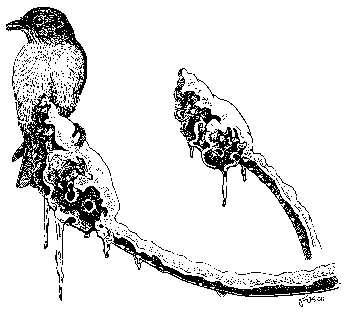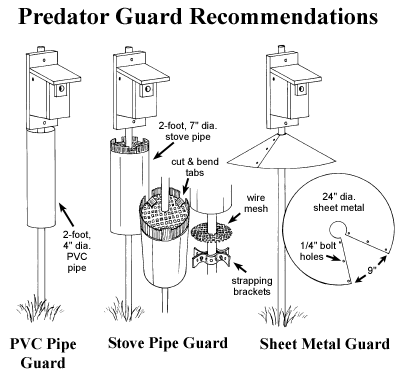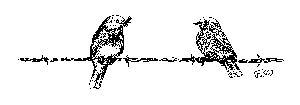Eastern Bluebird
Sialia sialis
Background Information
Common throughout Connecticut in the early to mid-1800s, the Eastern Bluebird, one of the most loved and beneficial birds, declined in numbers from the late 1800s through the 1980s. One significant contributing factor to this decline was the lack of suitable nesting cavities needed by the bluebird to successfully raise young. This lack of nesting cavities resulted from changing land use patterns and increasing urbanization. Competition for nesting cavities from introduced European starlings and house sparrows, the loss of open field habitats, pesticide use, and severe weather conditions have also played a role in the decline of bluebird populations.
The construction of nest boxes and establishment of nest box "trails" in appropriate habitat is helping the bluebird make a comeback. Proper construction and placement of nest boxes will encourage bluebirds and not their alien competitors.
Description and Field Marks
Eastern Bluebirds are small members of the thrush family, measuring from six to eight inches in length. They have large eyes, round heads, and slender, short bills which are wide at the base.
The Eastern Bluebird is the only bluebird species found in New England. Mountain and Western Bluebirds are found west of the prairie states. The male Eastern Bluebird has a bright blue back and reddish-brown breast, sides, and flanks. The underparts are white. The coloration of the female is similar, although paler and more muted than that of the male. Juvenile bluebirds are grayish, with brown and white spots on the back and breast; only the wings and tail show any blue.
During the breeding season, as part of the courtship display, males may flutter the tips of their long, pointed wings after landing. Bluebirds have a squat appearance when perched.
The song is a sweet, melodious whistling and the call is a rising "chur chur-lee chur-lee." Both sexes may sing, although male bluebirds are most often heard singing from their nesting territories early in the breeding season. Bluebirds also utter a variety of short call notes.
Habitat
Birds of semi-open habitat, bluebirds prefer orchards, parklands, meadows, and other areas with scattered trees and short ground cover. They perch in the open, scanning the ground for their prey of insects and spiders. In the fall and winter, their diets change to wild fruits and berries. Small flocks of bluebirds may be seen foraging along the edges of wooded swamps. During fall migration, dogwood and viburnum berries are very important foods. Typical winter foods are the fruits of Virginia creeper, eastern red cedar, sumac, bayberry, honeysuckle, winterberry, and many other berry-producing shrubs and vines.
Breeding
Bluebirds search for natural cavities or nest boxes along the edges of woods or pastures, and in orchards, meadows, and large gardens. Hollow limbs, holes in trunks, or deserted woodpecker "apartments" are used as nest sites. These cavities range from three to 30 or more feet above ground. Competition with starlings for these natural cavities often forces bluebirds to seek nest boxes. The nest, built by the female, is composed chiefly of grass, but often contains fine rootlets, pine needles, or deer hair. The three to seven eggs are oval and light blue in color. White eggs are possible, but rare. Eggs are laid from early April to mid-August in Connecticut. Incubation, done mostly by the female, normally takes 13 to 14 days, but can take longer in cold weather. Bluebirds produce two broods yearly, and sometimes three if weather conditions are favorable and food supplies are adequate.
Distribution in New England
Bluebirds are both migrants and summer residents in New England. They may be winter residents in southern New England, and they are becoming more common year-round in certain areas of Connecticut.
Parasites
Bluebirds are sometimes infected by the parasitic blowfly (Protocalliphora sialia), which prefers cavity-nesting birds. The cycle of this parasite begins when the adult female blowfly lays eggs in the nesting material. When the eggs hatch, the larvae attach themselves to the nestlings at night and suck their blood. When gorged sufficiently, the larvae burrow back into the nesting material, surrounding themselves with a flexible membrane to resemble a small brown egg. This is the pupal stage. In 10 to 14 days, adult blowflies emerge from the pupal case, or puparia, and fly away to repeat the cycle.
Ordinarily, no action against this parasite needs to be taken. If other stress factors, such as prolonged rain, drought, or food shortages occur, blowfly parasitism can seriously weaken nestlings and control measures may be necessary to save the brood. Removal of the larvae or replacement of heavily infested nests (with dry straw) are the best control techniques. Pesticides like rotenone or pyrethrins may be effective, but they will also kill a tiny parasitic wasp (Nasonia vitripennis) that controls blowflies naturally by preying on blowfly pupae. Few studies have been done on the effects of these pesticides on wild birds.
Installing and Monitoring a Nest Box
The following are tips for establishing and maintaining a successful bluebird nest box. They apply to both backyards and bluebird nest box trails.
- Select good habitat. Open, rural country with low or sparse ground cover and scattered trees is best. Pastures, large lawns, golf courses, parks, and cemeteries are all good sites for nest box trails. Vandalism and excessive human disturbance may present problems in some public places. Poor habitat selection often results in more house sparrows rather than bluebirds.
- Avoid brushy and heavily wooded areas. These habitats are far more suitable for house wrens, which will probably dominate existing nest boxes.
- Avoid areas where house sparrows are abundant. Do not place the boxes close to houses or barns. House sparrows will kill bluebirds and destroy eggs and young.
- Avoid areas of pesticide use.
- Face boxes toward open areas in any direction. Ideally, the entrance hole should face away from prevailing winds. A tree or suitable perch 40 to 100 feet from the box provides a perfect rest stop for young on their first flight.
- Keep boxes at least 100 yards apart. This allows the bluebirds to establish a territory around the nest box.
- Protect boxes against predators. Snakes, raccoons, housecats, and other predators can quickly reduce bluebird numbers. Repeated nest box raids often cause abandonment of the box. Follow the tips for predator guards on page 3 to prevent bluebird losses.
- Monitor the boxes. Check them once a week during the nesting season to record progress of the nestlings and to control house sparrows. Establishing a nest box trail in a loop is most convenient for monitoring. You will end up near where you started monitoring and avoid disturbing the birds as you backtrack.
- Always remove house sparrow nests immediately when found. To encourage second or third broods, remove bluebird and other nests as soon as young birds fledge from the nest box.
- Inspect boxes in early fall and late winter; clean and repair if necessary. Bluebirds are less likely to nest in a box that has an old nest in it. Old nests increase the numbers of parasites in the box, often resulting in nest failure.
- Keep a bluebird journal. Record the date, species using the box, number of nestlings, number of young fledged, and any other interesting observations.
- Share your results. Complete and return a Bluebird Nest Box Survey Card. These postage-paid cards help the Wildlife Division’s Nonharvested Wildlife Program monitor bluebird populations statewide. Relatives, friends, and neighbors are often delighted to hear about your results, too. You may interest someone else in bluebird conservation!
New boxes and trails should be established and older boxes cleaned and repaired prior to the start of the bluebird nesting season. Ideally, boxes should be available by mid-March in Connecticut. However, since bluebirds have more than one brood a year, boxes may be put up at any time of the year. The success rate for box use drops as the nesting season progresses.
What Else Can You Do to Help?
Learn to recognize the nest and eggs of the house sparrow and remove them from your nest box. House sparrow nests, eggs, adults, and young are not protected by law and may be legally removed or destroyed. It may take many weeks of removal to discourage house sparrows from using your bluebird box.
A house sparrow nest is very sloppy. It is made of coarse grass, rootlets, leaves, straw, and possibly bits of cloth and litter, which fill the cavity. It often has a domed roof when built in a nest box and may vary in size. The three to seven eggs are oval and white, gray or greenish, with irregular, brown speckles.
Quick Guide to Nest Identification
Bluebird: a neat nest of fine grasses or pine needles.
Tree swallow: a nest of grasses lined with feathers.
Black-capped chickadee or tufted titmouse: a downy nest of mosses, fur, and soft plant fibers.
House wren: a messy nest of twigs, occasionally lined with finer fibers.
House sparrow: a nest with a jumble of odds and ends, such as grasses, cloth, feathers, twigs, and possibly bits of litter.
Plant native trees, shrubs, and vines that will provide fall and winter food for bluebirds.
The following are some bluebird favorites:
Trees
American Mountain Ash (Sorbus americana)
Shadbush (Amelanchier canadensis)
Flowering Dogwood (Cornus florida)
Alternate-leaf Dogwood (Cornus alternifolia)
American Holly (Ilex opaca)
Shrubs
Highbush Cranberry (Viburnum trilobum)
Gray Dogwood (Cornus racemosa)
Silky Dogwood (Cornus amomum)
Red-osier (red-stemmed) Dogwood (Cornus stolonifera)
Smooth Sumac (Rhus glabra)
Staghorn Sumac (Rhus typhina)
Vines
Virginia Creeper (Parthenocissus quinquefolia)
Grape (Vitus spp.)
Use "paired boxes" if nesting bluebirds are harassed or driven off by tree swallows. Quickly set up a second box 20 to 30 feet from the first. A tree swallow pair will select one box for nesting and defend the other box against use by other swallows, allowing the bluebirds to claim it. This strategy makes it possible to encourage the successful nesting of both the bluebirds and the equally beneficial tree swallows.
Bluebird Nest Box Plans and Instructions
The nest box illustrated below was designed by the Connecticut Bluebird Working Group. More skill is required for constructing this box, but it is easier to mount. This nest box has an entry-hole predator guard and opens on the side for easy monitoring and cleaning.

Plans for a simple, yet effective, nest box are illustrated below. The box is designed not only to meet bluebird needs, but to be durable and easy to clean and repair. It is easily constructed with hand tools and a minimum of materials.

Nest boxes can be made out of almost any wood, but cedar, pine, or cypress are preferred. Do not use pressure-treated lumber or exterior plywood, both of which are chemically treated and unsuitable for nest boxes. If rough-cut wood is not used, score or groove the interior surface of the front, below the entry hole, to aid nestlings in climbing out of the box.
Both nest box styles should be assembled using dry wall screws, which make repairs to the box easier. Use of Phillips-head screws helps deter curious passersby from opening the nest box.
If weatherproofing of the nest box is desired, the outside surface can be treated with linseed oil. Allow the oil to be totally absorbed before installing the box. It is best not to stain or paint nest boxes. However, a light-colored stain or latex paint may be applied to the outside of the nest box. Avoid using dark colors and never stain or paint the inside of the box or entrance hole.
Nest boxes should be mounted five feet above ground level on galvanized pipe or six- to seven-foot metal garden stakes. Flatten the tabs on the stakes to discourage raccoons. Boxes can be attached to metal stakes with carriage bolts or to galvanized pipe with screws or pipe brackets. Boxes should not be mounted on trees.
Pole-mounted nest boxes are still subject to predation. Predation rates vary dramatically from location to location and year to year. Three types of predator guards are shown below. Most experienced "bluebirders" have a favorite style; however, no single design is favored unanimously. All do agree that an additional predator guard is very important and, in some areas, essential to successfully raising bluebirds.

Keep a Nest Box Journal
Maintaining a log or journal on your nest boxes helps document box success or failure for end-of-season surveys. A journal provides information on when eggs are expected to hatch, when young are likely to make their first flights, and why a problem may have developed with the nestlings. Keep records in a way that makes sense to you and is easy to complete. Some suggestions:
Date: time and weather conditions
Nest: type, materials used, date started, date completed, height of nest
Eggs: number, date first egg laid, date last egg laid
Young: number, hatch date, age (hatch date = day 1), condition
Parasites: type, any control measures taken
Fledglings: number, date
Comments: any observations of interest, such as competitors, predation problems, banding information, behavioral notes
 The Bluebirder's Timetable
The Bluebirder's Timetable
Nest building: 1 - 6 days
Egg laying: 5 - 7 days
Incubation: 13 - 14 days
Fledging: 16 - 21 days
Aging of Bluebird Nestlings
Determining the age of young bluebirds is extremely difficult. The size, weight, and development of nestling birds vary greatly and are dependent on food, weather, temperature, and the number of birds in a nest. Despite these variations, some common clues can help you approximate the age of nestling bluebirds.
Day 1: Eyes closed; black down on head and sometimes spine; young are a little larger than egg.
Day 2-4: Eyes closed; body weight has at least doubled; feathers begin to appear as dark areas on wings and head (day 4).
Day 5-7: Eyes open as slits; feathers break through skin on wings and head; feathers begin to open (day 7).
Day 8-11: Eyes wide open; primary wing feathers still opening; weight is 75 percent of adult weight. By day 11, wing feathers on males may appear bright blue and on females, pale blue-gray. Nestlings may preen a little.
Day 12-21: White eye ring; young actively stretching, preening, and flexing their wings.
Note: Opening the nest box after day 12 is not advisable unless a problem arises. The increasingly active nestlings may fall or hop out of the nest box, reducing their chances for survival.
For More Information
DEEP Wildlife Division's Nonharvested Wildlife Program at deep.wildlife@ct.gov or 860-424-3011.
North American Bluebird Society
Content last updated December 12, 2019.

